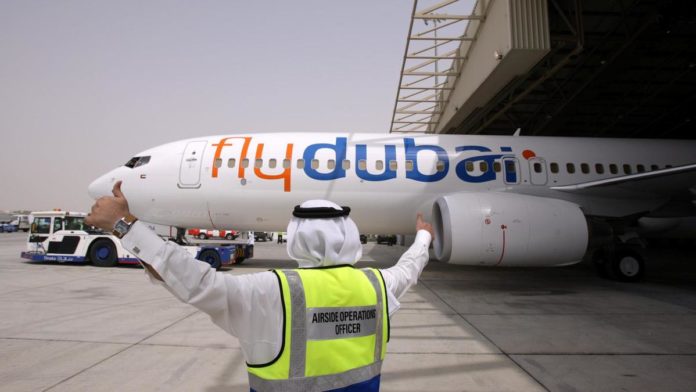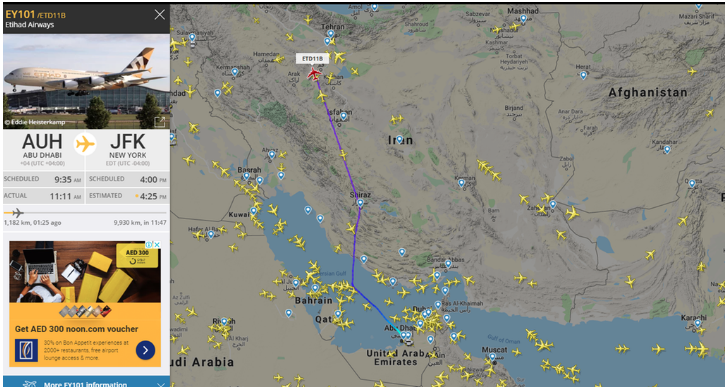Emirates and Flydubai adjust routes after US bans flights over Iranian waters.
Etihad Airways also monitoring the situation as British Airways, Qantas and Lufthansa follow US airlines in not flying jets over the Strait of Hormuz and Gulf of Oman.
Emirates and Flydubai said on Friday they had begun to reroute some of their flights after the US Federal Aviation Administration issued an emergency order prohibiting American carriers from flying over Iranian waters.
Low-cost carrier Flydubai said it had “adjusted” some of its flight paths.
Shortly after, a spokesperson for Emirates said: “In light of the current situation, Emirates has taken precautionary measures including rerouting all flights away from areas of possible conflict.”
Earlier on Friday the UAE’s national carrier Etihad Airways said it was “carefully monitoring the current situation”.
“Contingency plans are in place, and we will decide what further action is required after carefully evaluating the FAA directive to US carriers,” the spokesperson said.
“We are working closely with the UAE General Civil Aviation Authority.”

The order by the US aviation body, due to heightened tensions with Iran, came hours after United Airlines suspended flights between New Jersey’s Newark airport and Mumbai, which fly through Iranian airspace, following a safety review after Iran shot down a high-altitude US surveillance drone.
Following United Airlines, two other US carriers – American Airlines and Delta Air Lines – also confirmed they are not flying over Iran. Lufthansa, the German airline, said on Friday that its planes will not fly over the Strait of Hormuz and the Gulf of Oman. British Airways said it too was to reroute flights.
Earlier on Friday several flights that took off from the UAE for US-bound destinations were flying over Iran per flightradar24.com monitoring.
Australia’s flag carrier, Qantas Airways, also said that its flights over the Middle East would avoid the Strait of Hormuz and Gulf of Oman following the downing of a US surveillance drone in the region.
The restriction will mean a slight change to the route for flights between Australia and London, the airline said in a statement.
United said it had suspended its flights to India through Iran airspace after a “thorough safety and security review”. It did not say how long the suspension would last.
A United spokesman said customers flying from Mumbai to Newark would be booked on alternative flights.
“We continue to explore all our options and remain in close contact with relevant government authorities in order to provide our customers with the most efficient travel experience under these circumstances,” the spokesman said.
The downing of the unarmed Global Hawk aircraft was the latest of a series of incidents in the Gulf region, a critical artery for global oil supplies, that included explosive strikes on six oil tankers.
FAA said according to flight tracking applications, the nearest civil aircraft was operating within around 45 nautical miles of a US Global Hawk drone when it was shot down by an Iranian surface-to-air missile.
“There were numerous civil aviation aircraft operating in the area at the time of the intercept,” FAA said.
The agency said it remained concerned about the escalation of tension and military activity within close proximity to high volume civil aircraft routes as well as Iran’s willingness to use long-range missiles in international airspace with little or no warning.
In July 2014, Malaysia Airlines Flight MH17 was shot down by a missile over Ukraine, killing all 298 on board, prompting carriers to take more steps to uncover threats to their planes.
The US prohibition does not apply to airlines from other countries, but Opsgroup said it would be taken into consideration by carriers globally. Opsgroup monitors the world’s airspace and airports for risks that affect its 5000 member airlines, pilots, controllers and dispatchers.
“Since MH17, all countries rely on advice from the US, UK, France and Germany to highlight airspace risk,” Opsgroup said. “The threat of a civil aircraft shootdown in southern Iran is real.”































